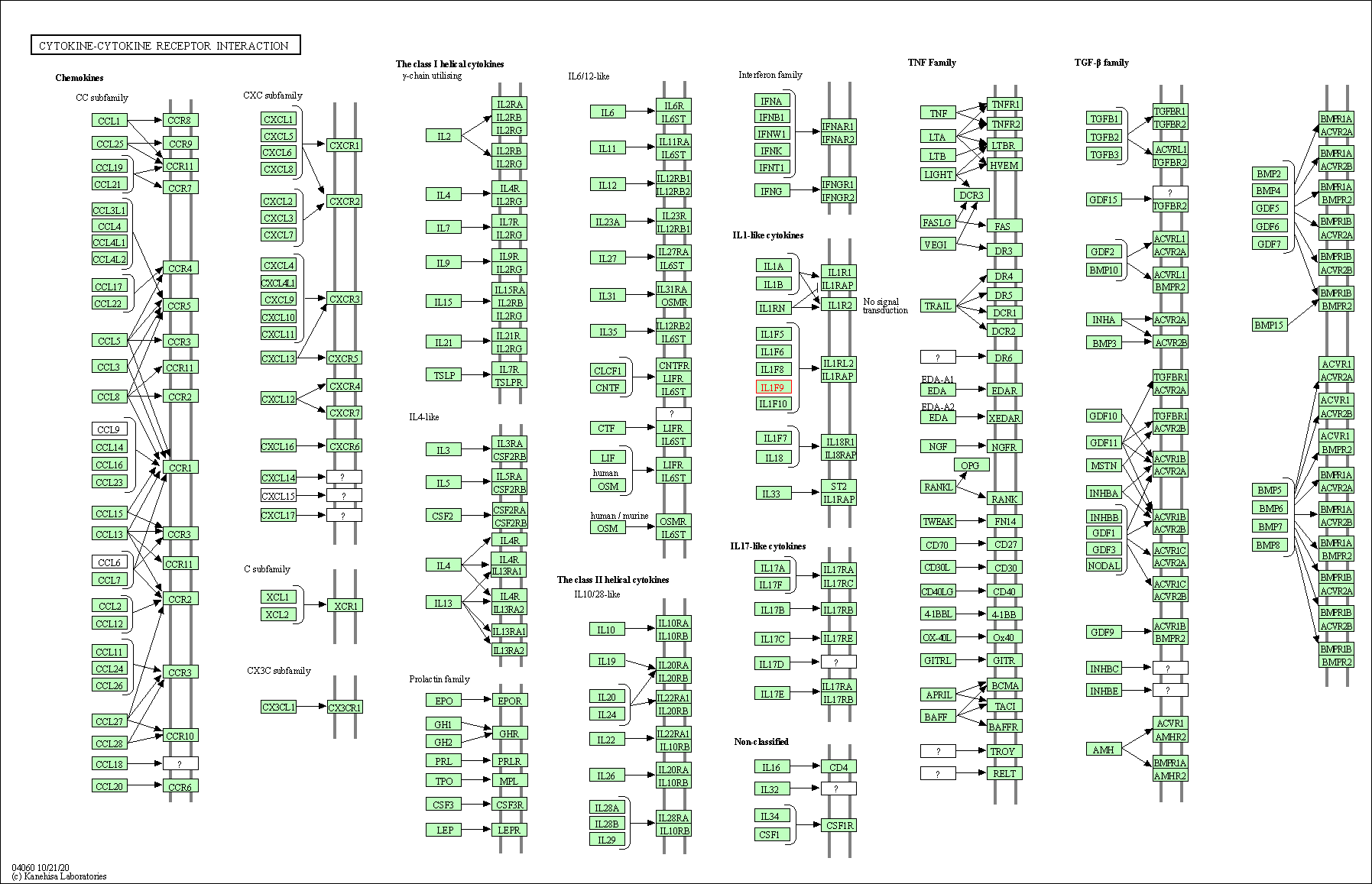Target Information
| Target General Information | Top | |||||
|---|---|---|---|---|---|---|
| Target ID |
T72514
|
|||||
| Target Name |
Interleukin-36 gamma (IL36G)
|
|||||
| Synonyms |
IL-1-related protein 2; IL-1RP2; Interleukin-1 epsilon; IL-1 epsilon; Interleukin-1 family member 9; IL-1F9; Interleukin-1 homolog 1; IL-1H1
Click to Show/Hide
|
|||||
| Gene Name |
IL36G
|
|||||
| Target Type |
Clinical trial target
|
[1] | ||||
| Disease | [+] 1 Target-related Diseases | + | ||||
| 1 | Solid tumour/cancer [ICD-11: 2A00-2F9Z] | |||||
| Function |
Cytokine that binds to and signals through the IL1RL2/IL-36R receptor which in turn activates NF-kappa-B and MAPK signaling pathways in target cells. Part of the IL-36 signaling system that is thought to be present in epithelial barriers and to take part in local inflammatory response; similar to the IL-1 system with which it shares the coreceptor IL1RAP. Seems to be involved in skin inflammatory response by acting on keratinocytes, dendritic cells and indirectly on T-cells to drive tissue infiltration, cell maturation and cell proliferation. In cultured keratinocytes induces the expression of macrophage, T-cell, and neutrophil chemokines, such as CCL3, CCL4, CCL5, CCL2, CCL17, CCL22, CL20, CCL5, CCL2, CCL17, CCL22, CXCL8, CCL20 and CXCL1; also stimulates its own expression and that of the prototypic cutaneous proinflammatory parameters TNF-alpha, S100A7/psoriasin and inducible NOS. May play a role in proinflammatory responses during particular neutrophilic airway inflammation: activates mitogen-activated protein kinases and NF-kappa B in primary lung fibroblasts, and stimulates the expression of IL-8 and CXCL3 and Th17 chemokine CCL20 in lung fibroblasts. May be involved in the innate immune response to fungal pathogens, such as Aspergillus fumigatus.
Click to Show/Hide
|
|||||
| UniProt ID | ||||||
| Sequence |
MRGTPGDADGGGRAVYQSMCKPITGTINDLNQQVWTLQGQNLVAVPRSDSVTPVTVAVIT
CKYPEALEQGRGDPIYLGIQNPEMCLYCEKVGEQPTLQLKEQKIMDLYGQPEPVKPFLFY RAKTGRTSTLESVAFPDWFIASSKRDQPIILTSELGKSYNTAFELNIND Click to Show/Hide
|
|||||
| 3D Structure | Click to Show 3D Structure of This Target | PDB | ||||
| Drugs and Modes of Action | Top | |||||
|---|---|---|---|---|---|---|
| Clinical Trial Drug(s) | [+] 1 Clinical Trial Drugs | + | ||||
| 1 | mRNA-2752 | Drug Info | Phase 1 | Solid tumour/cancer | [2] | |
| Mode of Action | [+] 1 Modes of Action | + | ||||
| Replacement | [+] 1 Replacement drugs | + | ||||
| 1 | mRNA-2752 | Drug Info | [1] | |||
| Cell-based Target Expression Variations | Top | |||||
|---|---|---|---|---|---|---|
| Cell-based Target Expression Variations | ||||||
| Drug Binding Sites of Target | Top | |||||
|---|---|---|---|---|---|---|
| Ligand Name: (2S)-2-{[4-(3-amino-4-methylphenyl)-6-methylpyrimidin-2-yl]oxy}-3-methoxy-3,3-diphenylpropanoic acid | Ligand Info | |||||
| Structure Description | Crystal structure of IL-36gamma complexed to A-552 | PDB:6P9E | ||||
| Method | X-ray diffraction | Resolution | 2.00 Å | Mutation | No | [3] |
| PDB Sequence |
KPITGTINDL
30 NQQVWTLQGQ40 NLVAVPRSDS50 VTPVTVAVIT60 CKYPEALEQG70 RGDPIYLGIQ 80 NPEMCLYCEK90 VGEQPTLQLK100 EQKIMDLYGQ110 PEPVKPFLFY120 RAKTGRTSTL 130 ESVAFPDWFI140 ASSKRDQPII150 LTSELGKSYN160 TAFELNIN
|
|||||
|
|
||||||
| Click to View More Binding Site Information of This Target with Different Ligands | ||||||
| Different Human System Profiles of Target | Top |
|---|---|
|
Human Similarity Proteins
of target is determined by comparing the sequence similarity of all human proteins with the target based on BLAST. The similarity proteins for a target are defined as the proteins with E-value < 0.005 and outside the protein families of the target.
A target that has fewer human similarity proteins outside its family is commonly regarded to possess a greater capacity to avoid undesired interactions and thus increase the possibility of finding successful drugs
(Brief Bioinform, 21: 649-662, 2020).
Human Pathway Affiliation
of target is determined by the life-essential pathways provided on KEGG database. The target-affiliated pathways were defined based on the following two criteria (a) the pathways of the studied target should be life-essential for both healthy individuals and patients, and (b) the studied target should occupy an upstream position in the pathways and therefore had the ability to regulate biological function.
Targets involved in a fewer pathways have greater likelihood to be successfully developed, while those associated with more human pathways increase the chance of undesirable interferences with other human processes
(Pharmacol Rev, 58: 259-279, 2006).
Human Similarity Proteins
Human Pathway Affiliation
|
|
| Protein Name | Pfam ID | Percentage of Identity (%) | E value |
|---|---|---|---|
| Interleukin-36 beta (IL36B) | 40.449 (36/89) | 3.13E-19 | |
| KEGG Pathway | Pathway ID | Affiliated Target | Pathway Map |
|---|---|---|---|
| Cytokine-cytokine receptor interaction | hsa04060 | Affiliated Target |

|
| Class: Environmental Information Processing => Signaling molecules and interaction | Pathway Hierarchy | ||
| References | Top | |||||
|---|---|---|---|---|---|---|
| REF 1 | Clinical pipeline report, company report or official report of Moderna Therapeutics. | |||||
| REF 2 | ClinicalTrials.gov (NCT03739931) Dose Escalation Study of mRNA-2752 for Intratumoral Injection to Participants With Advanced Malignancies. U.S. National Institutes of Health. | |||||
| REF 3 | Small Molecule IL-36Gamma Antagonist as a Novel Therapeutic Approach for Plaque Psoriasis. Sci Rep. 2019 Jun 24;9(1):9089. | |||||
If You Find Any Error in Data or Bug in Web Service, Please Kindly Report It to Dr. Zhou and Dr. Zhang.

